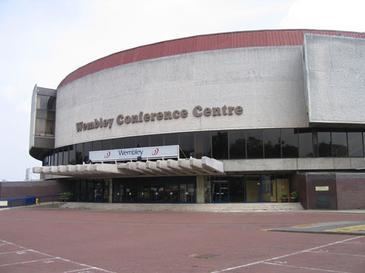Broke ground May 1973 Demolished September 2006 Destruction date 2006 Destroyed by Demolition | Closed 2006 Opened 31 January 1977 Capacity 2,500 Architect Richard Seifert | |
 | ||
Similar Skonto Hall, Villa Louvigny, Green Glens Arena, Point Theatre, Grand Théâtre de Luxembourg | ||
Wembley conference centre opening colour
Wembley Conference Centre was a conference centre in Wembley Park, Wembley, London, England.
Contents
History
In the later 1970s, modern multi-purpose halls began opening in British towns and cities. The first was Wembley Conference Centre on Empire Way in Wembley Park, designed for the British Electric Traction Company by R. Seifert and Partners. Construction began in May 1973 and it was officially opened by the Duke of Kent on 31 January 1977. Its main auditorium (called the Grand Hall) could seat 2,500 people.
The Conference Centre was part of a larger development. Next to it were the 722m² Greenwich Rooms and Elvin House, a futuristic triangular office block, as well as the Wembley Exhibition Centre. Like the Conference Centre, the Exhibition Centre was part of a national trend for such venues.
The addition of the Conference Centre and exhibition hall to the list of visitor attractions at Wembley Park led to Wembley Hill station being renamed Wembley Complex in May 1978. It would retain this name until May 1987, when it was again renamed, this time as Wembley Stadium.
In preparation for a major redevelopment of both Wembley Stadium and the area immediately surrounding it, the conference centre building was demolished in September 2006.
Events
An early event was the January 1977 Model Engineer Exhibition, which had previously been held at the Seymour Hall in Marylebone. On 7 May 1977 the Centre was the venue for the Eurovision Song Contest, where the United Kingdom came second. On 18 October 1977 it hosted the first ever Brit Awards ceremony (then called the 1977 BPI Awards).
The Centre was used for numerous conferences, trade events, exhibitions, corporate hospitality, annual general meetings, university graduation ceremonies, banquets, indoor sport and popular music. However, a classical music concert by the National Youth Orchestra suggested the Centre’s acoustics were at best mediocre, in addition to which it was hard for classical music to attract large enough audiences to fill the Grand Hall.
In terms of sport, the Conference Centre is perhaps best remembered as being the venue for the Benson & Hedges Masters snooker tournament from 1979 to 2006. Other sports held there included boxing, wrestling, body building and darts.
On 30 August 1995, the Centre hosted the first ever National Television Awards presented by Eamonn Holmes.
On 7 November 1999, it hosted the darts match between the reigning PDC World Champion Phil Taylor and the reigning BDO World Champion Raymond van Barneveld, with a 60-minute clock ticking down to zero and with a short break around the half-way stage. The match was broadcast on ITV. Taylor won the match 21–10 in legs.
It hosted three Ricky Hatton boxing matches where he was victorious. 21 October 2000, he defeated fellow Briton Jon Thaxton by unanimous decision, In 26 March 2001, he defeated Canadian Tony Pep with a fourth round TKO two and a half minutes in and on 15 December 2001, he defeated Australian Justin Rowsell with a second round TKO with thirty six seconds to go.
During Live Aid (13 July 1985) the Conference Centre and exhibition halls were used to provide dressing rooms for the performers.
Between 10 July 2004 and 22 April 2006, it hosted ten Cage Rage mixed martial arts events.
In popular culture
In 1979 the Conference Centre was considered sufficiently futuristic to stand in for a conference centre on the colonised planet Atlay in the BBC science fiction series Blake’s 7, in an episode called ‘Voice from the Past'.
The entrance to the conference centre was also used in Superman IV: The Quest for Peace.
